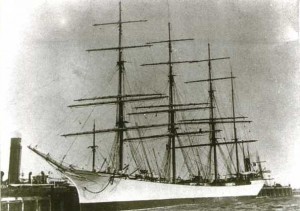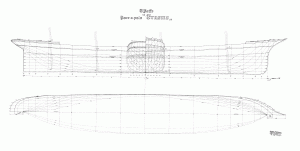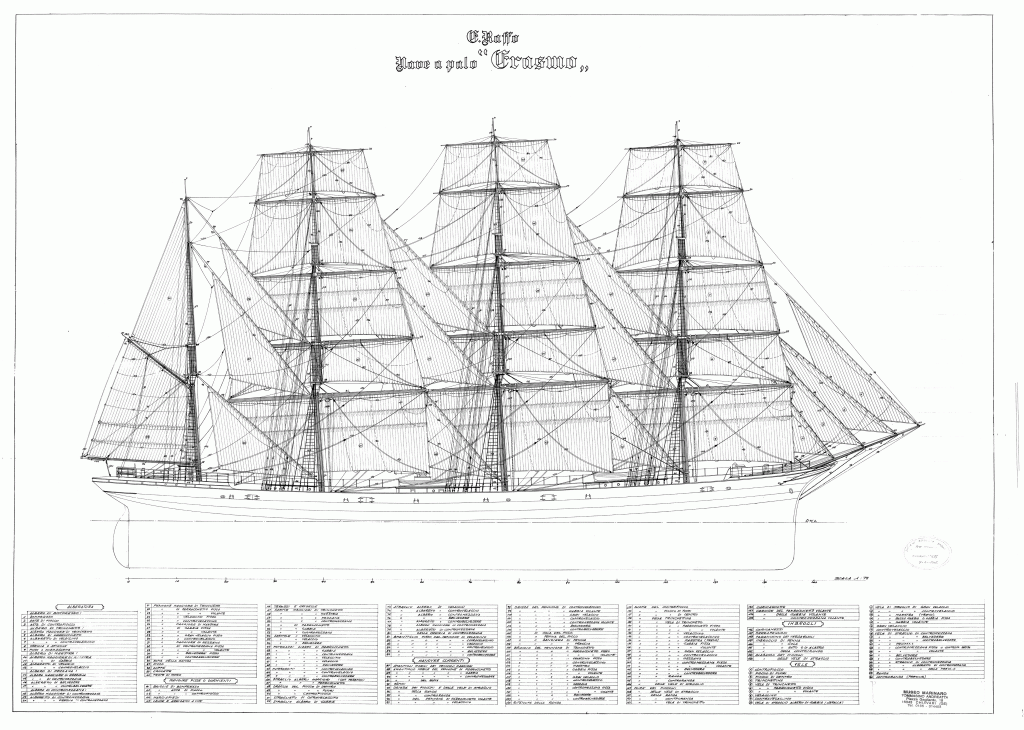By the end of the 18th Century, the term ‘barque’ referred to a specific sail plan of three or more masts with fore-aft sails on the aft-most mast and square sails on the others. Barques could nearly match the speed of ship-rigged clippers, and surpassed the performance of schooners and barkentines. They could operate with smaller crews than a full-rigged ship as well, making them more economical to operate. (1)
The four-masted, steel-hulled barque Erasmus was built in 1903 by the shipyards Riva Trigoso, Genoa, on behalf of the shipping company Raffo & Bacigalupo of Chiavari. She had a net tonnage of 2,197 tons. On June 12 1903 sailed from Genoa to the Atlantic for the first voyage under the command of Capt. Lorenzo Queirolo Zoagli. After 42 days at sea, in sight of the American coast, she was a dismasted by a storm.(2)
She was returned to her home port across the Atlantic by The Amsterdam Tug and Salvage Company tug Titan, which “towed across the Atlantic of the four-masted sailing ship Erasmo, of 2,157 tons net register. this ship, we learn from a testimonial from the Italia Insurance Company of Genoa, arrived at Philadelphia with loss of her main and mizzen masts. She was transported to Genoa by the Titan in the worst season of the year. Nevertheless, the Titan and her commander Capt. J. Bakker, succeeded in taking her to the Italian port to the entire satisfaction of both underwriters and owners.” (3)
After repairs, she sailed to Sydney, Australiad under the command of Captain Luigi Raimondo di Imperia then continue voyages in the Pacific, generally between Australia and Chile. (4) However, she apparently on occasion made the run around Cape Horn to the eastern U.S. seabord, as The Sydney Morning Herald noted in July 1909 “The Italian four-masted barque Erasmo, which has a part cargo of general merchandise from New York for Sidney sailed from Melbourne yesterday in continuation of her voyage.(5)
Erasmo receives another mention in Australian shipping news in The Bunbury Herald in December of the following year “With the exception of the Italian barque Erasmo, which is now 25 days out from Wallaroo (S.A.), the only vessel expected to arrive for timber during the present week is the coastal steamer Monaro.” (6)
A mention in The Sydney Morning Herald in June 1912 indicates she also made the complete antipodal voyage when, in a piece headlined “A Rough Passage; Barque Erasmo Damaged” and datelined June 11, Rio de Janeiro, it is noted “The Italian four-masted steel barque Erasmo, which left Port Pirie [South Australia] in March last with 38,318 bags of wheat for Falmouth [England] has put in here seriously damaged in consequence of the heavy weather she encountered. Three of her crew have been drowned and one injured, and her cargo has been damaged.” (7)
In 1913 Erasmo was sold to a german shipping company, renamed the Penguin, and put to use as a “nitrate clipper” hauling guano from chile to Hamburg. She made only two trips before being laid up for four years during World War I. In 1921 she was sold to a French company, but only two years later she was broken in Bruges. (8)
High-resolution PDF plans (massive 3′ x 5′ plans can be printed at local copy shop):
Erasmus sail and rigging plan
Sources:
(1) Wikipedia: http://en.wikipedia.org/wiki/Barque retrieved February, 2013
(2) Agencia Bozzo: http://www.agenziabozzo.it/vecchie_navi/A-Vecchie_Vele/A-124_nave_a_palo_ERASMO_1903_Esercizio_Bacini_Riva_Trigoso.htm retreived February, 2013
(3) The Syren and Shipping, Volume 2, July 17, 1907
(4) Agencia Bozzo, Id.
(5) The Sydney Morning Herald (NSW : 1842 – 1954) Saturday 13 March 1909
(6) Bunbury Herald (WA : 1892 – 1919) Thursday 22 December 1910
(7) The Sydney Morning Herald (NSW : 1842 – 1954) Wednesday 12 June 1912
(8) Agencia Bozzo, Id.



[…] in Genoa, Italy in 1903, the four-masted, steel-hulled barque Erasmo (Erasmus) sailed from Europe to Australia and to […]
I built a 1:100 model of Erasmo in 2016 in Brazil. It took me one year to finish It.
It is in a glass case im my living room
I am trying to determine the actual length of the hull for comparison to another steel-hulled barque built in Ireland – the Sindia. In drawings of the ship I see a scale 1:75, but don’t know the actual size of the drawings. There is a measuring line drawn beneath the hull, increments of 10 units, which ends at ‘140’ If meters, this would seem entirely too long. Any information would be appreciated!
Thanks for visiting the website.
If you left-click on the plan image it will open the full-size image file. Right-click on that large image, choose “save image as” and choose a destination on your computer to download the plan. You can take the file to a print shop that has an architectural drawing printer and print it out for comparison.
Alternately, you can zoom into the full size image to read the details of the plan.
[…] Italian four-masted barque Erasmo (Erasmus) […]